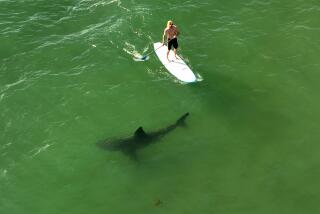Peter Benchley, 65; ‘Jaws’ Author Became Shark Conservationist
Peter Benchley, whose first novel, “Jaws,” sold 20 million copies and helped invent the Hollywood summer blockbuster film when Steven Spielberg made the tale of a bloodthirsty shark into a 1975 movie, has died. He was 65.
Benchley, who became a conservationist and expressed regret over portraying sharks as killing machines, died Saturday of idiopathic pulmonary fibrosis, a progressive and fatal scarring of the lungs, at his home in Princeton, N.J., his wife, Wendy, said.
The movie became one of the top-10 grossing films of all time, when adjusted for inflation, according to Box Office Mojo, a website that tracks theatrical receipts. It also caused ocean-goers to be terrified of even dipping a toe into the sea.
“Spielberg certainly made the most superb movie; Peter was very pleased,” Wendy Benchley told Associated Press. “But Peter kept telling people the book was fiction, it was a novel, and that he took no more responsibility for the fear of sharks than Mario Puzo took responsibility for the Mafia,” she said, referring to Puzo’s screenplay and novel “The Godfather.”
“Jaws” was “entirely fiction,” Peter Benchley repeated in a London Daily Express article that appeared last week.
“Knowing what I know now, I could never write that book today,” said Benchley, who also co-wrote the screenplay for “Jaws.” “Sharks don’t target human beings, and they certainly don’t hold grudges.”
The 1974 novel, about a shark that terrorizes an East Coast resort community, spent more than 40 weeks on the New York Times bestseller list and made Benchley one of the most successful first novelists in literary history.
Some critics took issue with the tale of blood and horror for its weak characterizations, subplots and allusions to Herman Melville’s “Moby Dick,” especially in the final scene.
“None of the humans are particularly likable or interesting,” Rolling Stone said in 1974. “The shark was easily my favorite character -- and one suspect’s Benchley’s also.”
Originally titled “Silence in the Water,” the book got its concise name after Benchley asked his father, children’s author Nathaniel Benchley, to help him think of a title. His 200 suggestions included “Wha’s That Noshin’ On My Laig.’ ”
For a time “The Jaws of Leviathan” was a candidate until someone pointed out that Leviathan, a monstrous sea creature, was a mammal. “Jaws” was the only word that editor and author could agree on, the Los Angeles Times reported in 1974.
Many of Benchley’s novels relied on the formula of an ocean setting and menace lurking under the waves.
“The Deep” (1976) included sharks, but the main threat came from drug dealers trying to protect their cargo of heroin on the sea floor. “The Island” (1979) dealt with Caribbean pirates in the 17th century, a topic that Benchley researched extensively. Both books became movies.
Peter Bradford Benchley was born May 8, 1940, in New York City. He traced his interest in the sea, and sharks, to visits to Nantucket Island in Massachusetts.
When he was 15, his father offered him a small salary to write every day for a summer. By the time Peter turned 21, he had a literary agent from the same firm that represented his father. His grandfather was the celebrated humorist Robert Benchley.
After graduating from Harvard University in 1961, Benchley became a reporter at the Washington Post and spent three years as an associate editor at Newsweek. He later went to the White House, where he wrote “difficult” speeches about the Vietnam War for President Johnson, his wife told Associated Press.
His interest in using sharks as the main character of a novel grew in 1965 when he read a story about a huge shark caught off Montauk, Long Island. Doubleday gave Benchley $1,000 for an option and asked him to submit 100 pages.
The first five pages of the manuscript drew raves, but the rest required much revision. The result was a symbol of fear that lingers more than 30 years later.
Benchley’s other novels included “The Girl of the Sea of Cortez” (1982), an idyllic take on a young girl’s fascination with the sea and its inhabitants, and “Q Clearance” (1986), which he described as “a spy comedy.”
The Times’ 1986 review of “Q Clearance” said the book’s appeal rested in its “merciless sendup” of easily recognized bureaucrats and called it a “prime example of that vanishing literary species, the comic novel.”
With “Beast” (1991), Benchley returned to the familiar formula of “lethal creatures, relentless pursuers and vast quantities of saline solution,” Time magazine said in 1991. “White Shark” (1994) was more of the same.
He seemed to use the 2002 nonfiction book “Shark Trouble” as a way to make up for the earlier shark hysteria he had caused. The book begins with Benchley chiding the media for naming 2001 “the year of the shark attack,” noting that there were no more attacks that summer than any other.
In recent years, Benchley became an active advocate for shark protection. He campaigned against shark fisheries and traveled around the world to make undersea documentaries that had him swimming with sharks and whales. He also lectured on marine conservation.
His final book, the nonfiction “Shark Life” (2005), was aimed at educating young readers about the dangers of the sea.
Near the end of his life, Benchley expressed a revisionist take on his tale of ocean-going terror to the Daily Express.
“I hope that ‘Jaws’ will have brought sharks into the public interest at a time when we desperately need to reevaluate our care for the environment,” he said.
Besides his wife, Benchley is survived by three children and five grandchildren.
More to Read
Sign up for our Book Club newsletter
Get the latest news, events and more from the Los Angeles Times Book Club, and help us get L.A. reading and talking.
You may occasionally receive promotional content from the Los Angeles Times.








